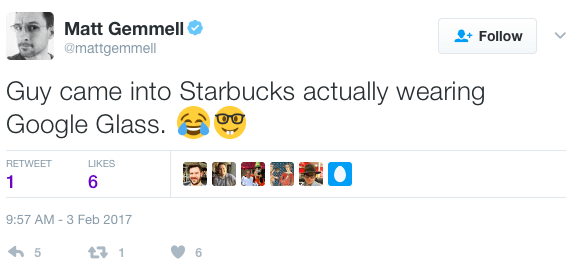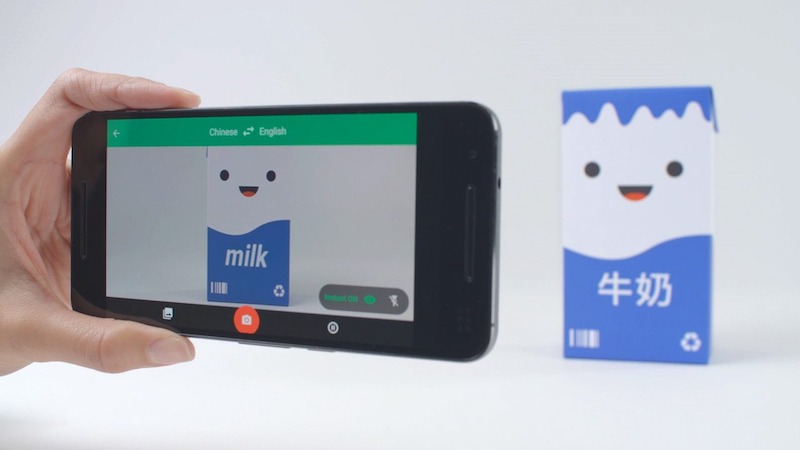Digital strategist Bas Grasmayer examines how augmented reality is progressing in the world of mobile, and how it will change the music business.
We are still in the midst of the mobile revolution, but the next medium is already emerging. “As big as the smartphone” is what Apple CEO Tim Cook recently dubbed augmented reality (AR). It’s a technology that follows the trend of mobile handheld devices to wearables smoothly, and one which will impact every area of the music business as our digital lives are transformed.
Google Glass & the social hurdle
One of the first large-scale experiments with augmented reality was the Google Glass rollout in 2014. There was something about people walking around with cameras on their faces, and others not knowing if they’re recording, that made it kind of awkward to wear the glasses. It was often met with ridicule and in some cases even aggression.
Still today, people are uncomfortable with it, as can be gleaned from a simple search on Twitter:
After about a year of being publicly available, Google retired Glass in early 2015 in order to redesign it. Now, a Silicon Valley outsider has beaten Google to making something considered as fun instead of creepy.
Spectacles by Snap
Snap, the company behind Snapchat, was no stranger to augmented reality. Their photo and video filters, which are responsible for all the dogface selfies, are a great example of AR. The filters layer virtual content on real world objects, in this case our faces, and it interacts as we perform actions with the real world objects, such as raising our eyebrows or opening our mouths. And there are plans to go beyond the face.
Snapchat and Pokemon Go have made augmented reality mainstream. Snapchat’s filters have even been used to promote music, like Sage the Gemini’s Now and Later.
In November 2016, Snap launched a new product: Spectacles. They’re sunglasses that can capture video and save it to Snapchat. The big difference with Google Glass is that Spectacles don’t try to replace the mobile phone: the ambition is just to extend the functionality and make it easier for people to create content. While the privacy implications are not that different from Google Glass, in this case people find the product fun, and not quite as creepy.
It shows that, if done right, augmented reality can get past the social hurdles and achieve much wider adoption, right now.
Beyond the headsets
Ultimately, these head-mounted devices will be to augmented reality what the dial-up modem was to the internet. What lies beyond the headset is the contact lens. Sony already has a patent for a contact lens which does something similar to Snap’s Spectacles, and activates through intentional blinks. Other technology companies are working on lenses that provide graphical user interfaces through AR, such as eMacula by Innovega.
When these technologies are finally rolled out in the form of compelling (and affordable) consumer products, they’ll have to fit into a landscape of connected devices and smart sensors. Our homes are getting increasingly connected and devices like Google Home and Amazon Echo can be seen as tech giants’ declarations of the intention to be in the middle of all that.
Once your home is smart, and artificial intelligence can process your likely intentions or desires, interacting with a home through smart contact lenses becomes a lot easier to imagine. The interface of a mobile screen for information retrieval, social interaction, or even ordering food, will seem as archaic as teletext does to most of us now.
So how will augmented reality change the music business?
It will change music videos, it will change advertising (so it will change sync), it will change the way we do business. Download the Google Translate app, open up the camera inside, open a foreign website and hold the camera over it — you can now read Chinese, congratulations.
Augmented reality is much bigger than music, and music will have to find its place in this new landscape. The way people interact with the world will change, so this will also affect the expectations of music. People already use music to augment their reality, but perhaps they’ll come to expect greater flexibility from music.
What music will become is impossible to predict, but what is certain is that augmented reality will give rise to a new generation of media companies who will get to define that future.
When television becomes radio
Gary Vaynerchuk, a well-known entrepreneur and investor, often refers to the moment that television started to overtake radio as the dominant medium. It gave rise to a new set of huge companies, new personalities, and spawned a whole industry. And now, he argues, television is becoming radio and mobile is the new television, and one of the best bets you can make is doubling down on the platform and making sure you scale up with the rapidly growing platforms.
There’s a lot of value in being an early adopter. You’ll understand a medium before anyone else does. You’ll have a head start and when adoption of a platform or technology picks up, you have a good chance to scale as rapidly as the medium itself.
After mobile, will come augmented reality.
It’s why Facebook is investing so much in virtual reality and dedicating 8 one-hour sessions to the topic at F8, their developer conference next April (check out this video of Zuckerberg receiving a call through Messenger while demoing Oculus VR).
Riding the first waves of augmented reality are people and companies who have added to their strategy things like: live video, ephemeral content like Snapchat, filters like Snapchat’s, vlogging, virtual reality, artificial intelligence, and conversational interfaces like chatbots or voice-activated devices such as Google Home.
They’re the ones best positioned when mobile becomes radio, and augmented reality becomes television.
Don’t forget to subscribe to our Synchtank Weekly newsletter to receive all of our blog posts via email, plus key industry news, and details of our podcast episodes and free webinars.


